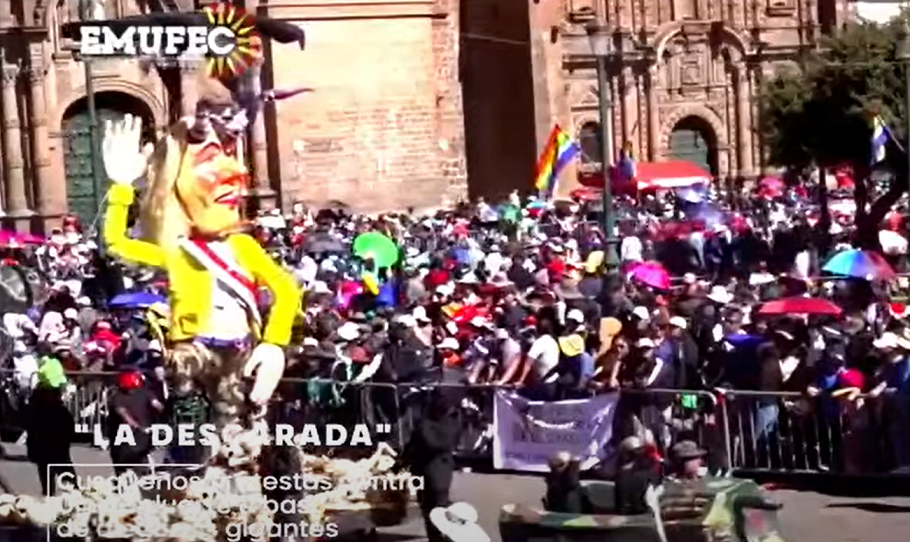 Dispatches
DispatchesPeruvian law students from the Facultad de Derecho, Universidad Nacional de San Antonio Abad del Cusco are reporting for JURIST on law-related events in and affecting Perú. All of them are from CIED (Centro de Investigación de los Estudiantes de Derecho), a research center in UNSAAC’s faculty of law dedicated to spreading legal information and improving legal culture through study and research, promoting critical and reflective debate to contribute to the development of the country. Vanesa Escobar Marcavillaca is a law student from UNSAAC and a member of CIED. She files this dispatch from Cusco.
June represents a very special month for people in Cusco, Peru. Colorful streets full of dancers, clothes and the most elaborate and traditional meals can be seen in its anniversary month. And of course, there’s a whole week full of people parading as a way to celebrate their city.
On June 18th, the University of Diego Quispe Tito, which is an arts college, joined the important parade celebrating the birthday of the city of Cusco. Participation in this parade is prized, and artists show off their best artworks.
César Aguilar was one of these artists, and he decided to use his creativity in a very controversial allegory. He made up a representation which he called “La Descarada”, or “The shameless woman”. This was a reference to Peruvian president Dina Boluarte, consisting of a woman dressed up as a soldier, stepping on skulls. Two horns come out of the piece’s head, and there’s also a black hand controlling it as a puppet.
Some Peruvian context could be very helpful for understanding the meaning of this allegory. First, the Peruvian government has been very unsteady in the last few years. In the past five years alone, Peru has had six different presidents. One of the last ones was Pedro Castillo Terrones, who remained in the presidency for almost two years, between 2021 and 2022, although the normal period lasts five years. But his term didn’t have a happy ending after he tried to dissolve the Congress on December 7, 2022. That was not the first time a president took such a decision, however. Ex-President Martín Vizcarra also did it in 2019, and he was strongly supported by the country. But not this time. In the middle of rejection instead of acceptance, Pedro Castillo was quickly captured by Peruvian authorities and hours later, he was ousted from the presidency. Being the only vice president in office at that time, Dina Boluarte succeeded Pedro Castillo in the government.
But the Peruvian people didn’t want Dina to stay in the government. The huge political crisis prompted Peruvians to call for other people to take charge. But the people were never listened to. And that’s how a very long list of protests began in December 2022 and turned Peru into a very unstable country, where many people didn’t recognize Dina Boluarte as their president. Even so, Dina Boluarte never stepped down from government. On the contrary, as she announced she would continue on in the presidency until 2026. She also decided to repress the protests violently through the police and armed forces. As a result, 61 people died.
Even the Inter-American Commission on Human Rights (CIDH), in its report made in May 2023, confirmed that human rights such as liberty of expression and right to protest have been seriously affected in Peru.
One month later, César Aguilar decided to represent all the suffering of Peru’s people through art. As we said, the woman he made up was a clear reference to Dina Boluarte. The skulls between the feet of La Descarada represent, painfully, all the lives lost in the protests, lives that nobody responded to, even though it’s well-understood that policemen and military forces should take responsibility for extinguishing those lives. But that was not what happened, and it’s not the reality. Rather, President Boluarte has shown absolute support for the cruel way in which these people acted. Knowing this, the dressing of the allegory makes total sense. And the black hand over her represents Dina being controlled by powerful people, to the Peruvian people’s detriment. Everyone, or, at least, everyone who still feels indignant, loved this piece of art. But not the government.
After the parade on June 18th was over, local news reported the allegory had been abruptly removed. But that’s not the worst part. The next day, nobody knew where it was. That’s how “La Descarada” finally disappeared. Even now, no one knows its whereabouts.
One might think this was a very weird robbery, except for the threats César Aguilar has been receiving from Peruvian authorities, including people from the Culture Ministry. In a recent interview, César revealed he’s been pressured to issue a public apology to President Dina Boluarte, which he says is not an option for him. Lots of Peruvian artists have meanwhile made a joint statement supporting César, and emphasizing the terrible way in which freedom of expression is being affected by this action. Nowadays, it seems like any opinion different from that of the government will be repressed in all possible ways, even if that means taking the life of those who are against Dina Boluarte, “La Descarada”.

